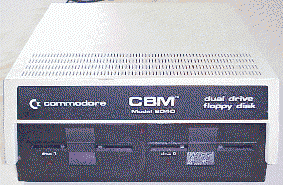



These big, boat-anchor disk drives are single device, dual unit monstors. They
use an IEEE-488 interface to talk to the PET and 'B' line machines. They were
apparantly very expensive to manufacture, meaning they were not likely to be
home consumer devices. For this reason, Commodore made them big, sturdy,
and high capacity (well, for it's day). The capacity was 170K per disk, using
a Commodore-invented encoding scheme called GCR. This format, unlike the MFM
format still used by PCs, allowed more of the surface of a disk to be utilized
by staggering the number of sectors among different track numbers. The standard
media accepted by these drives is Double or Single-Sided, Double-Density (DSDD)
5.25" floppy disks.
Like all Commodore disk drives, these drives were "smart" devices. They included their own processor, their own memory, and their own disk operating system. In fact, the relationship between a Commodore computer and it's disk drive resembles more closely two computers on a network than a typical Computer->peripheral relationship. The peripherals on the IEEE-488 "network" each had a unique identifying "Unit" number, typically ranging from 8-30. This number identified which physical device was being accessed. When a disk drive contained more than one floppy drive (like the dual drives on this page), you also had to refer to the particular "drive" number you wanted (typically 0 or 1).
Model : 2040 Type : Dual 5.25" Floppy Disk Media : Single Sided, Single Density Capacity : 170K per disk, or 360K total Interface: IEEE-488 Dos : CBM DOS 1.0 Notes :
Model : 3040 Type : Dual 5.25" Floppy Disk Media : Single Sided, Single Density Capacity : 170K per disk, or 360K total Interface: IEEE-488 Dos : CBM DOS 1.0 Notes :
Model : 4040 Type : Dual 5.25" Floppy Disk Media : Single Sided, Single Density Capacity : 170K per disk, or 360K total Interface: IEEE-488 Dos : CBM DOS 2.0 Notes :
Click here to return to the main pictures page
If you find anything in here you have questions or comments about, feel
free to leave me email right here.
To return to my home page, click here.